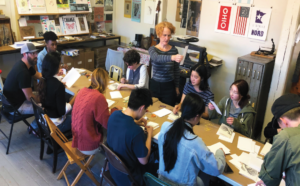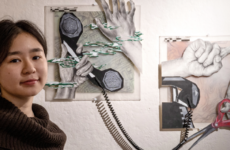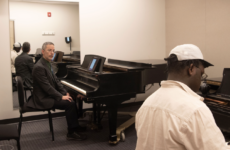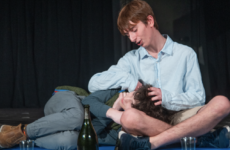
Visual Arts Concentration students participate in a workshop led by Dexterity Press, a letterpress studio. Photo by Derek Ng/The Choate News
When someone mentions the words “visual arts”, what do you think of? For many students, including Choate’s Visual Arts Concentration (VAC) program members, the first art mediums they think of are graphite pencils, charcoal sticks, or paint palettes. In this term’s VAC field trip, the arts department has arranged visits to a local artist’s shop in New Haven to introduce the students to what seems a lesser-known art form: printmaking.
Printmaker Mr. Jeff Mueller owns and operates Dexterity Press print shop. Working alongside his wife, Ms. Kerri Sancomb, Mr. Mueller presses and sells a wide variety of prints: cards, posters, banners, and even customizable skateboard decks.
The VAC students took part in designing wooden stamps used in the printing press. Before the first visit of the trip, the students sketched black-and-white images that served as stencils for the stamps, which the studenta carved using wood-dissolving chemicals. On the second visit, DateTk, the finished stamps were placed into Mr. Mueller’s 1905 printing press, which uses rollers to pick up ink and press it onto the paper, to print a small book with each student’s designs.
While traditional art forms allow artists to freely change the design at any point, printmaking uses meticulously carved stamps that are difficult to alter once created. For VAC student Stella Dubin ’21, the lack of flexibility in printmaking was a new experience.
“I think printmaking is very formulaic and very controlled — once you make the stamp, the design’s pretty much set, which doesn’t leave much room for error,” Dubin said. “It’s not something I’m super familiar with. I’m not a super loose artist, but if I make a mistake I can fix it if it’s just graphite or any other medium. But I can’t with printmaking.”
HP Park ’21 is a Visual Arts Concentration student who specializes in computer-generated imagery, 3-D graphics modeling, and virtual reality. Park related the printmaking process to his work with generating graphics using image templates.
“I sometimes use AI [artificial intelligence] to generate landscapes. If I want to make a lot of trees, and I have one tree, I can generate a terrain from a template of that one tree. It’s like an algorithm; all the branches and leaves are randomized with each generated tree,” Park said. “It’s similar to how the printing works mechanically, with one layer of color, then another layer, then a third after, each a little bit different from the other layers.”
Park raised the possibility of implementing a special texture-defining plane used in modern 3-D graphics software in physical print pressing. “In 3-D, there’s a thing called the normal plane, which defines how a texture may look on a 3-D plane surface. If we could make normal maps for printing, we could change bumpiness on a paper print — not just color or opacity, but unique textures, which would be pretty cool,” Park said.
“I like going to artists’ studios because you get to see an in-depth view of their artistic process,” Dubin said. “I like museums — they’re great — but the idea of going into a studio is interesting because it shows a bit about the artist and how they do things. You get to know them, versus just looking at a painting on a wall.”
“I have always viewed making art as something that takes up a lot of your energy. After visiting this studio and print making, I realized that art can be a meditational experience. It was super relaxing,” Vlada Sirychenko ’20 said.




